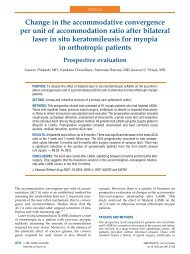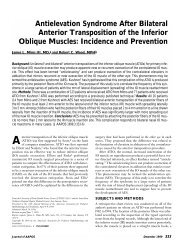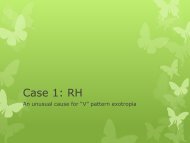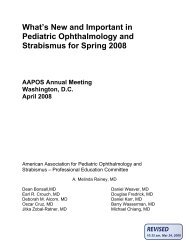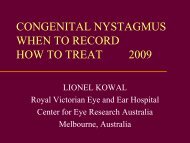Epidemiology of amblyopia - The Private Eye Clinic
Epidemiology of amblyopia - The Private Eye Clinic
Epidemiology of amblyopia - The Private Eye Clinic
You also want an ePaper? Increase the reach of your titles
YUMPU automatically turns print PDFs into web optimized ePapers that Google loves.
Seminar<br />
Visual acuity Age (years) Prescribed regimens<br />
(h/day)<br />
PEDIG (n=189) 38 6/12–6/24 3 to 6–12 h: 3·0<br />
n/a=not available. NS=non-significant differences between groups. *Measured with occlusion dose monitor. †None <strong>of</strong> the outcomes differed significantly between groups within each trial,<br />
apart from the ROTAS study, which was analysed by actual patching hours. ‡With 1 h <strong>of</strong> near visual activities.<br />
Table 4: Patching dose studies<br />
the PEDIG comparison <strong>of</strong> atropine with patching, 14,61<br />
reduction <strong>of</strong> the hypermetropic spectacle correction was<br />
undertaken at an interim visit if the child had not<br />
responded. Another randomised trial is currently being<br />
done by PEDIG, comparing atropine with and without a<br />
plano spectacle lens (results expected in 2006 or 2007).<br />
Since one dose <strong>of</strong> 1% atropine lasts up to 2 weeks, a less<br />
than daily dosing schedule might also be reasonable.<br />
PEDIG compared daily atropine with twice weekly<br />
atropine (given on Saturday and Sunday) in moderate<br />
<strong>amblyopia</strong> (6/12 to 6/24). 64 <strong>The</strong> improve ment in visual<br />
acuity was 2·3 lines in each group, and the researchers<br />
concluded that weekend atropine provides an improvement<br />
in visual acuity <strong>of</strong> similar magnitude as daily atropine.<br />
During atropine therapy, vision in the treated eye should<br />
be checked to ensure that no iatrogenic reverse <strong>amblyopia</strong><br />
has taken place. 65 This check <strong>of</strong> visual acuity poses a<br />
difficulty, since optical aberrations caused by pupillary<br />
dilatation <strong>of</strong>ten result in a slight reduction <strong>of</strong> visual acuity<br />
even if accommodative factors are corrected by full<br />
hypermetropic correction. Never theless, the two PEDIG<br />
studies 14,64 found only one <strong>of</strong> 372 patients treated with<br />
atropine was actively treated for reverse <strong>amblyopia</strong>, and<br />
only two patients had a drop <strong>of</strong> more than one line from<br />
baseline, at last follow-up.<br />
Another reason for previous unpopularity <strong>of</strong> atropine<br />
has been a perception that the treatment would not be<br />
effective unless fixation switched to the amblyopic eye.<br />
Consequently, atropine was thought not to be effective in<br />
severe <strong>amblyopia</strong>. PEDIG studies 64,66 have shown that<br />
fixation switch, or reduction <strong>of</strong> near visual acuity <strong>of</strong> the<br />
healthy eye beyond that <strong>of</strong> the amblyopic eye, is not<br />
needed for atropine to be effective. We speculate that<br />
atropine could be effective even without a fixation switch<br />
by blurring <strong>of</strong> higher spatial frequencies in the atropinised<br />
eye. Another PEDIG study is currently investigating<br />
atropine in severe <strong>amblyopia</strong>.<br />
How much patching<br />
Until recent trials, 67,68 the amount <strong>of</strong> patching prescribed<br />
has been entirely a matter <strong>of</strong> individual preference. Some<br />
researchers have argued for full-time occlusion,<br />
recommending at least three cycles 69 <strong>of</strong> a week <strong>of</strong> full-time<br />
occlusion per year <strong>of</strong> age. Others have preferred to patch<br />
less intensively (a few h per day), recognising that treatment<br />
could take longer than expected but could be just as<br />
effective with the advantage <strong>of</strong> being less disruptive.<br />
Patching has been investigated in several randomised<br />
trials (table 4). 38,54,70,71 Although the PEDIG studies 38,54 and<br />
the study by Awan and colleagues 70 were somewhat<br />
restricted by failure to wait for maximum improvement<br />
<strong>of</strong> visual acuity with spectacles alone, they show that<br />
many children improve with much less patching than<br />
has <strong>of</strong>ten been prescribed. Notably, substantial individual<br />
variability <strong>of</strong> response to patching has been recorded 72<br />
and recent data 73 suggests that 1 h or more <strong>of</strong> actual<br />
patching per day is effective in many children. <strong>The</strong> panel<br />
summarises interpretation <strong>of</strong> data from all these recent<br />
trials and observational studies with an evidence-based<br />
approach to treating <strong>amblyopia</strong>.<br />
Compliance issues and side-effects <strong>of</strong> patching<br />
Occlusion dose monitors have confirmed that some<br />
children and families comply well with patching whereas<br />
Panel: Current treatment recommendations for <strong>amblyopia</strong> secondary to<br />
anisometropia, strabismus, or both<br />
● For diagnosis and monitoring <strong>of</strong> <strong>amblyopia</strong>, measure best-corrected visual acuity with<br />
logMAR-based tests<br />
● Prescribe refractive correction based on cycloplegic retinoscopy<br />
● Wear spectacles full time and monitor visual acuity every 6–12 weeks until stable<br />
● If <strong>amblyopia</strong> remains, discuss options <strong>of</strong> patching versus atropine<br />
● If patching treatment is used, start with a low dose (eg, 1–2 h per day) and monitor<br />
visual acuity every 6–12 weeks<br />
● If atropine treatment is given, start with twice weekly dose, and monitor visual acuity<br />
every 6–12 weeks<br />
● If improvement stops and <strong>amblyopia</strong> remains, consider increasing treatment or<br />
switching treatment<br />
If no further improvement occurs or <strong>amblyopia</strong> resolves, consider weaning treatment or stopping treatment, but follow for at<br />
least a year after stopping treatment, because <strong>of</strong> risk <strong>of</strong> recurrence.<br />
www.thelancet.com Vol 367 April 22, 2006 1347



